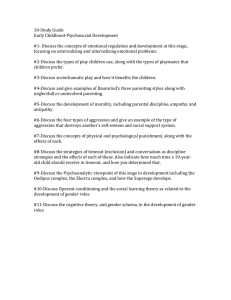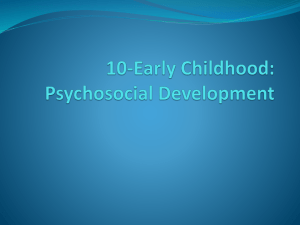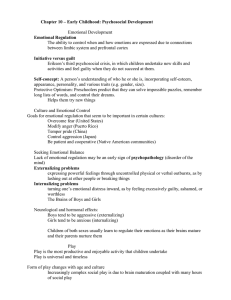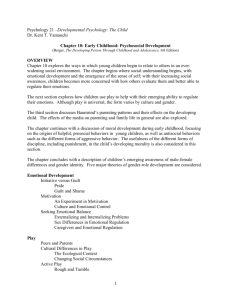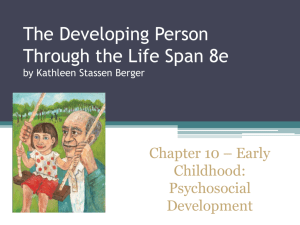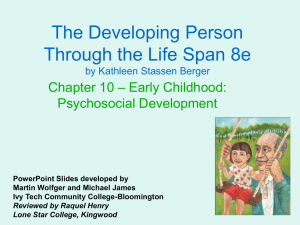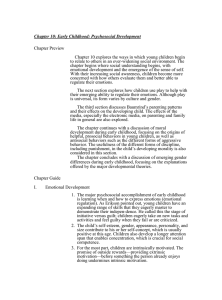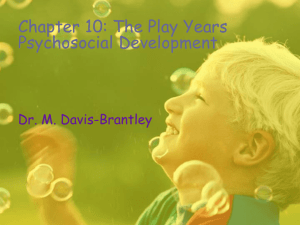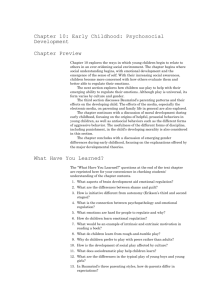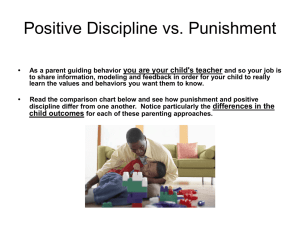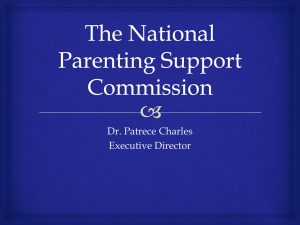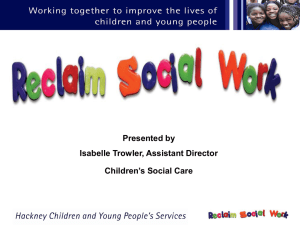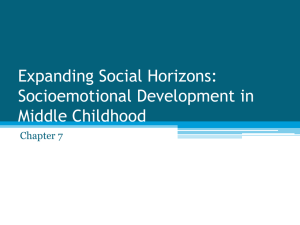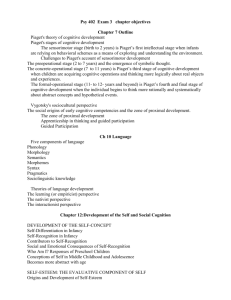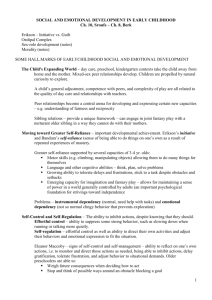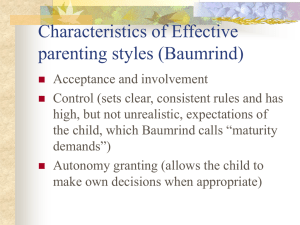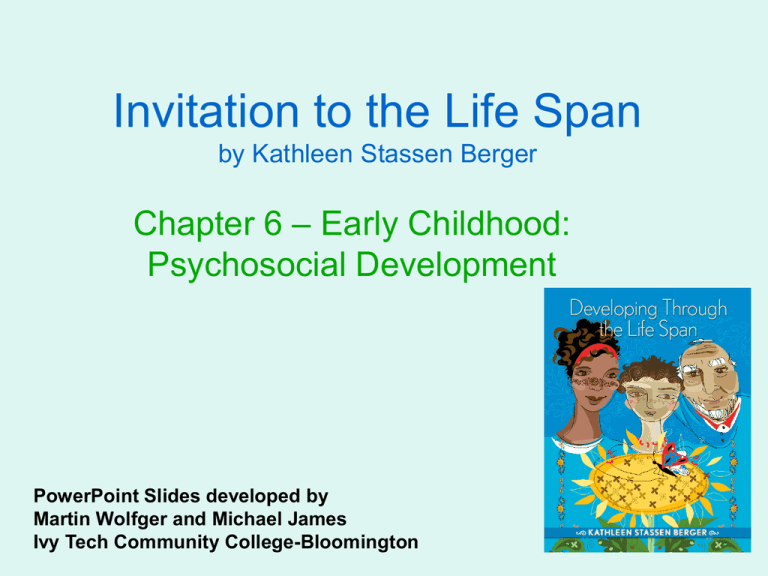
Invitation to the Life Span
by Kathleen Stassen Berger
Chapter 6 – Early Childhood:
Psychosocial Development
PowerPoint Slides developed by
Martin Wolfger and Michael James
Ivy Tech Community College-Bloomington
Emotional Development
• Emotional Regulation
– The ability to control when and how emotions are
expressed
– Possible due to connections between limbic system
and prefrontal cortex
• Initiative versus guilt
– Erikson’s third psychosocial crisis, in which
children undertake new skills and activities
and feel guilty when they do not succeed at
them.
Pride in Oneself
• Self-esteem: A person’s evaluation of his or her own
worth, either in specifics (e.g., intelligence,
attractiveness) or in general.
• Self-concept: A person’s understanding of who he or
she is, incorporating self-esteem, physical appearance,
personality, and various personal traits (e.g. gender,
size).
• Protective Optimism: Preschoolers predict that they
can solve impossible puzzles, remember long lists of
words, and control their dreams.
– Helps them try new things
Guilt and Shame
• Guilt: Self-blame that people experience
when they do something wrong
• Shame: People’s feeling that others blame
them, disapprove of them, or are
disappointed in them
Motivation
• Intrinsic motivation: A drive, or reason to
pursue a goal, that comes from inside a person
(e.g. the need to feel smart or competent).
• Extrinsic motivation: A drive, or reason to
pursue a goal, that arises from the need to have
one’s achievements rewarded from outside (e.g.
by receiving material possessions or another
person’s esteem).
Culture and Motives
• Goals for emotional regulation that seem
to be important in certain cultures:
– Overcome fear (United States)
– Modify anger (Puerto Rico)
– Temper pride (China)
– Control aggression (Japan)
– Be patient and cooperative (Native American
Communities)
Seeking Emotional Balance
• Lack of emotional regulation may be an early
sign of psychopathology
• Externalizing problems
– Involves expressing powerful feelings through
uncontrolled physical or verbal outbursts, as by
lashing out at other people or breaking things
• Intenalizing problems
– Involves turning one’s emotional distress inward, as
by feeling excessively guilty, ashamed, or worthless
Sex Differences in Emotional
Regulation
• Neurological and hormonal
effects:
– Boys tend to be aggressive
(externalizing)
– Girls tend to be anxious
(internalizing)
• Psychopathology is not typical!
– Children of both sexes usually
learn to regulate their emotions
as their brains mature and their
parents nurture them
Play
• Play is the most productive and enjoyable
activity that children undertake
• Play is universal
– Archeologists find toys that are many
thousands of years old
– Anthropologists report play in every part of the
world
Play
• Form of play changes with age and culture
– Increasingly complex social play is due to
brain maturation coupled with many hours of
social play
– Children must learn how to make, and keep,
friends
Peers and Parents
• Peers:
– People of about the same age and social
status
– Provide practice in emotional regulation,
empathy, and social understanding
– Children usually prefer to play with each other
rather than with their parents
The Ecological Context
• Physical setting of a culture shapes play
– Some communities provide many toys and
close supervision
– Others leave children to play on their own with
whatever they find
• Child-centered programs in the United
States
Changing Social Circumstances
Types of Play (Midred Parten, 1932)
1. Solitary play: A child plays alone, unaware of any other
children playing nearby.
2. Onlooker play: A child watches other children play.
3. Parallel play: Children play with similar toys in similar
ways, but not together.
4. Associative play: Children interact, observing each
other and sharing material, but their play is not yet
mutual and reciprocal.
5. Cooperative play: Children play together, creating and
elaborating a joint activity or taking turns.
Active Play
• Rough-and-tumble play: Play that mimics
aggression through wrestling, chasing, or hitting,
but in which there is no intent to harm.
– Expressions and gestures (e.g. play face) signifying
that the child is "just pretending”
– Particularly common among young males
– Ample space, distant adults, and presence of friends
increase likelihood
– Advances children’s social understanding but
increases likelihood of injury
– May positively affect prefrontal cortex development
Active Play
Sociodramatic Play
• Sociodramatic play: Pretend play in which
children act out various roles and themes in
stories that they create.
• Sociodramatic play enables children to:
– Explore and rehearse the social roles enacted around
them
– Test their ability to explain and to convince playmates
of their ideas
– Practice regulating their emotions by pretending to be
afraid, angry, brave, and so on
– Develop a self-concept in a nonthreatening context
Parenting Styles
Diana Baumrind (1967, 1971). Parents differ on
four important dimensions:
1. Expressions of warmth: From very affectionate to cold
and critical
2. Strategies for discipline: Parents vary in whether and
how they explain, criticize, persuade, ignore, and punish.
3. Communication: Some parents listen patiently to their
children; others demand silence.
4. Expectations for maturity: Parents vary in the
standards they set for their children regarding
responsibility and self-control.
Baumrind’s Patterns of
Parenting
• Authoritarian parenting: High behavioral standards,
strict punishment of misconduct, and little
communication
• Permissive parenting: High nurturance and
communication but little discipline, guidance, or control
• Authoritative parenting: Parents set limits and enforce
rules but are flexible and listen to their children
• Neglectful/uninvolved parenting: Parents are
indifferent toward their children and unaware of what is
going on in their children’s lives
Implications of Parenting Style
• Children of authoritarian parents tend to
– become conscientious, obedient, and quiet but not
especially happy
– feel guilty or depressed and blame themselves when
things don’t go well
– rebel as adolescents and leave home before age 20
Implications of Parenting Style
• Children of permissive parents tend to:
– be unhappy and lack self-control, especially in peer
relationships
– suffer from inadequate emotional regulation
– be immature and lack friendships (main reason for
their unhappiness)
– continue to live at home, still dependent, in early
adulthood
Implications of Parenting Style
• Children of authoritative parents tend to:
– be successful, articulate, happy with themselves, and
generous with others
– Be well-liked by teachers and peers, especially in
societies in which individual initiative is valued
The Significance of Content
• Violence on TV is often depicted as morally
acceptable.
• Children who watch televised violence become
more violent themselves.
• Racial and gender stereotypes are still evident in
children’s programs.
• Educational television may have positive effects.
• Experts recommend that parents limit their
young children’s television viewing and spend
more time talking and playing with them.
Moral Development
• Empathy: The ability to understand the
emotions and concerns of another person,
especially when they differ from one’s
own.
• Antipathy: Feelings of dislike or even
hatred for another person.
Prosocial and Antisocial
Behavior
• Prosocial behavior: Actions that are
helpful and kind but that are of no obvious
benefit to the person doing them.
– Increases from age 3 to 6
• Antisocial behavior: Actions that are
deliberately hurtful or destructive to
another person.
– Declines beginning at age 2
Types of Aggression
1. Instrumental aggression: Hurtful behavior that is
intended to get something that another person has and
to keep it.
2. Reactive aggression: An impulsive retaliation for
another person’s intentional or accidental action, verbal
or physical.
3. Relational aggression: Nonphysical acts, such as
insults or social rejection, aimed at harming the social
connection between the victim and other people.
4. Bullying aggression: Unprovoked, repeated physical
or verbal attack, especially on victims who are unlikely
to defend themselves.
Physical Punishment
• Some researchers believe that
physical punishment is harmless;
some don’t.
• Physical punishment increases
obedience temporarily, but
increases the possibility of later
aggression.
• Many children who are spanked do
not become violent adults; other
factors (e.g. poverty, temperament)
are stronger influences.
Other Forms of Punishment
• Psychological control: A disciplinary
technique that involves threatening to
withdraw love and support and that relies
on a child’s feelings of guilt and gratitude
to the parents.
• Time-out: A disciplinary technique in
which a child is separated from other
people and activities for a specified time.
Becoming Boys and Girls
• Age 2: Children know
whether they are boys or
girls and apply gender
labels consistently
• Age 4: Children are
convinced that certain toys
(such as dolls or trucks) are
appropriate for one gender
but not the other
Sex and Gender
• Sex differences: Biological differences between males
and females, in organs, hormones, and body shape.
• Gender differences: Differences in the roles and
behaviors that are prescribed by a culture for males and
females.
– Initial confusion about gender and sex
– Age 5: Increased awareness of sex and gender
differences
– Age 8: Belief that their biological sex is a permanent trait
– Increase of awareness of sex differences, preferences for
same-sex playmates and stereotypical gender activities
from age 2 to age 8
Theories of Gender Differences
Psychoanalytical Theory
• Phallic stage: Freud’s third stage of
development, when the penis becomes the
focus of concern and pleasure.
• Oedipus complex: The unconscious desire of
young boys to replace their fathers and win their
mothers’ exclusive love.
• Superego: In psychoanalytic theory, the
judgmental part of the personality that
internalizes the moral standards of the parents.
Theories of Gender Differences
• Electra complex: The unconscious desire
of girls to replace their mothers and win
their fathers’ exclusive love.
• Identification: An attempt to defend one’s
self-concept by taking on the behaviors
and attitudes of someone else.
Theories of Gender Differences
Behaviorism
• Gender differences are the product of
ongoing reinforcement and punishment
– "Gender-appropriate" is rewarded more
frequently than "gender-inappropriate"
behavior
• Social learning theory: Children notice
the ways men and women behave and
internalize the standards they observe
Cognitive Theory
• Gender schema: A child’s cognitive
concept or general belief about sex
differences, which is based on his or her
observations and experiences.
– Young children categorize themselves and
everyone else as either male or female, and
then they think and behave accordingly.
Androgyny
• Androgyny: A balance within one person
of traditionally masculine and feminine
psychological characteristics.

